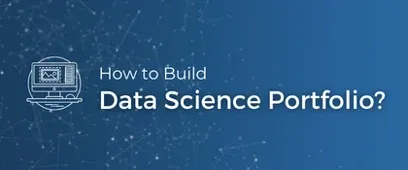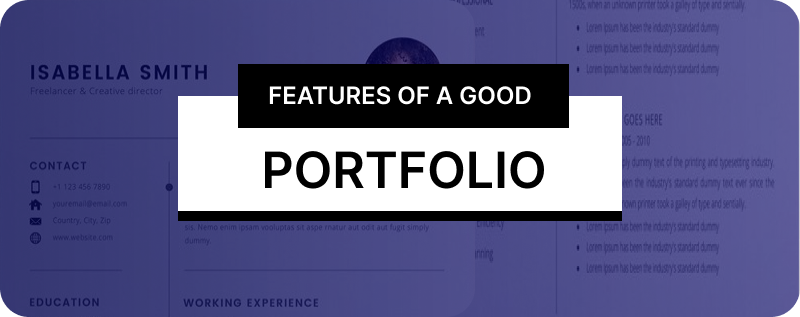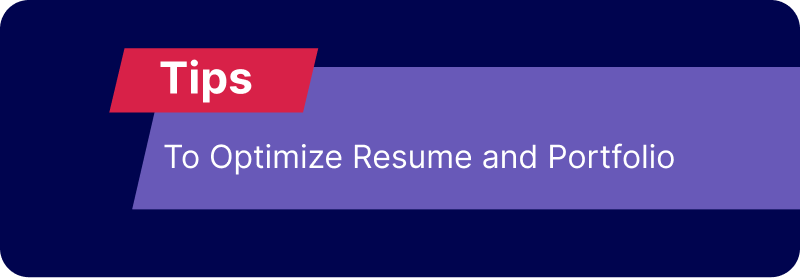Build your Data Science Portfolio, Resume, GitHub & Kaggle Profiles

Are you a budding Data Science professional? Does the thought of getting rejected by hiring managers keep you up at night? If yes, you are certainly not alone. A hiring manager goes through hundreds of Data Science profiles every day. The only way to make it to your dream job role is by making yourself stand out in the job market. This is where your Data Science portfolio steps in and saves the day.
Why is Data Science an in-demand field?

Although a relatively new field in the tech sector, Data Science has been around for a very long time and its concepts are as old as the 1940s; some of them have been around since the 1900s.
Computation was challenging; it took ages to calculate a simple linear regression. In the mid-1970s, most of the data science models were absolute. In early 2012, many data storage, processing, and visualization revolutions happened. It is around the same time that big data came into the picture.
The world was not the same after the introduction of 4G and the ability to store information in big data. Facebook, Yahoo, Netflix, Google, Microsoft, and Amazon are some of the early adopters of Science. For example, Facebook started using facial recognition to tag photos, Amazon used a product recommendations algorithm to do cross-sales, and Google was able to target ad campaigns to capture customers.
Thus, most companies consider Data Science an indispensable cutting-edge technology that helps business growth.
You may also want to read Data Science: The Cutting Edge Technology at the Climate Crisis Warfront
Why do you need a Data Science Portfolio?
What is a portfolio? A portfolio is a collection of works, tasks, records, and samples that help understand your data science knowledge.
As per businesstoys.in there has been a 650% increase in the demand for Data Science professionals since 2012. As a result, there are only around 97,000 job openings related to data science in India.
Some aspirants pursue engineering and opt for data science; some others graduate in Arts and venture into Data Science. Similarly, some people have several years of industry experience in unrelated fields and want to transition to data science.
You also find many people who do certifications in data science. However, few do 8 hours of data science courses and some 120 hours. This makes it quite challenging to calibrate a person's knowledge. In essence, owing to the exceptional demand for Data Science professionals recently, professionals from very diverse backgrounds have switched to Data Science.
No matter your background, your portfolio will demonstrate your expertise, experience, accomplishments, and, most importantly, your skills.
{% module_block module "widget_1119d75c-af8c-4ce7-a011-a220bf8e859d" %}{% module_attribute "child_css" is_json="true" %}{% raw %}{}{% endraw %}{% end_module_attribute %}{% module_attribute "css" is_json="true" %}{% raw %}{}{% endraw %}{% end_module_attribute %}{% module_attribute "definition_id" is_json="true" %}{% raw %}null{% endraw %}{% end_module_attribute %}{% module_attribute "field_types" is_json="true" %}{% raw %}{"image_desktop":"image","image_link":"link","image_mobile":"image"}{% endraw %}{% end_module_attribute %}{% module_attribute "image_desktop" is_json="true" %}{% raw %}{"alt":"Blog-Listing-Ad-_4_-3","height":300,"loading":"lazy","max_height":300,"max_width":1200,"size_type":"auto","src":"https://odinschool-20029733.hs-sites.com/hubfs/Blog-Listing-Ad-_4_-3.webp","width":1200}{% endraw %}{% end_module_attribute %}{% module_attribute "image_link" is_json="true" %}{% raw %}{"no_follow":false,"open_in_new_tab":true,"rel":"noopener","sponsored":false,"url":{"content_id":null,"href":"https://www.odinschool.com/datascience-bootcamp","type":"EXTERNAL"},"user_generated_content":false}{% endraw %}{% end_module_attribute %}{% module_attribute "image_mobile" is_json="true" %}{% raw %}{"alt":"Mobile-version-of-blog-ads-_5_-2","height":300,"loading":"lazy","max_height":300,"max_width":500,"size_type":"auto","src":"https://odinschool-20029733.hs-sites.com/hubfs/Mobile-version-of-blog-ads-_5_-2.webp","width":500}{% endraw %}{% end_module_attribute %}{% module_attribute "label" is_json="true" %}{% raw %}null{% endraw %}{% end_module_attribute %}{% module_attribute "module_id" is_json="true" %}{% raw %}132581904694{% endraw %}{% end_module_attribute %}{% module_attribute "path" is_json="true" %}{% raw %}"/OdinSchool_V3/modules/Blog/Blog Responsive Image"{% endraw %}{% end_module_attribute %}{% module_attribute "schema_version" is_json="true" %}{% raw %}2{% endraw %}{% end_module_attribute %}{% module_attribute "smart_objects" is_json="true" %}{% raw %}null{% endraw %}{% end_module_attribute %}{% module_attribute "smart_type" is_json="true" %}{% raw %}"NOT_SMART"{% endraw %}{% end_module_attribute %}{% module_attribute "tag" is_json="true" %}{% raw %}"module"{% endraw %}{% end_module_attribute %}{% module_attribute "type" is_json="true" %}{% raw %}"module"{% endraw %}{% end_module_attribute %}{% module_attribute "wrap_field_tag" is_json="true" %}{% raw %}"div"{% endraw %}{% end_module_attribute %}{% end_module_block %}
What should your Data Science Portfolio look like?

As we have understood what the importance of a data science portfolio is for your career, let us now try and understand the key points a hiring manager looks at in your data science portfolio:
-
Coding skills: Your hiring manager wants to see your knowledge, not codes. Coding practices are essential, which include the following:
Modular codes: Most of the codes written in organizations are reusable, which means using functions and object-oriented programming has a better edge than lame code. -
Look and feel: You can get good code even on Stack Overflow. Your hiring manager looks at not only the code but also the documentation of your code. If you can integrate your code into an application, it is well and good. If you don't have sound cross-platform knowledge, that's okay. Even a well-documented jupyter notebook can get you the same attention.
-
Data Processing Skills: Most budding data science professionals pay little attention to data preparation. They are under the impression that data science is just a plug-and-play model. Your hiring manager likes to look at how you can clean dirty data, impute missing values, transform, etc. More emphasis is provided on how to use statistics for data processing.
-
Data Visualization skills: There are visuals, and then there are meaningful visualizations. Now, let's understand what makes a good visualization.
-
Visuals that look good: Most visualisations need pleasant colour code, data labels, legends, and, most importantly, a title.
-
Visuals that help businesses make decisions: The visuals you create do need to provide some conclusions. The placing of your elements is also another important factor. For instance, you need to judge where to use a bar graph and where to use a pie chart.
-
Visual storyboarding: Storyboarding is a process of arranging your visuals meaningfully. It is a one-way communication where you communicate the problem and the solution using visuals.
-
Domain Knowledge: Hiring managers like to see how you can solve a business problem, the challenges, and the roadblocks. To solve any business problem, you need to have sound business acumen.
-
Model Optimization: Many aspirants create their portfolios, like creating a linear regression model or a classification model. A data science hiring manager is not interested in your tutorial but in some insights and practicality. For example, if you are trying to find housing prices, you won't apply for the linear model. Instead, you find whether the data is compatible with the assumptions of linear regression or if we have a better approach. Later, you can build a linear model and then try to improve accuracy with various data science techniques. You emphasize bias and variance issues, feature engineering, feature selection, parameter tuning, and data sampling, and not just linear regression. This linear model example can be applied to multiple models.
You may also want to read Tips to Prepare for Your Next Data Science Interview.
{% module_block module "widget_ef621fb0-c8bd-470c-9b1b-3c54fc4e295c" %}{% module_attribute "child_css" is_json="true" %}{% raw %}{}{% endraw %}{% end_module_attribute %}{% module_attribute "css" is_json="true" %}{% raw %}{}{% endraw %}{% end_module_attribute %}{% module_attribute "definition_id" is_json="true" %}{% raw %}null{% endraw %}{% end_module_attribute %}{% module_attribute "field_types" is_json="true" %}{% raw %}{"image_desktop":"image","image_link":"link","image_mobile":"image"}{% endraw %}{% end_module_attribute %}{% module_attribute "image_desktop" is_json="true" %}{% raw %}{"alt":"Blog-Listing-Ad-_4_-3","height":300,"loading":"lazy","max_height":300,"max_width":1200,"size_type":"auto","src":"https://odinschool-20029733.hs-sites.com/hubfs/Blog-Listing-Ad-_4_-3.webp","width":1200}{% endraw %}{% end_module_attribute %}{% module_attribute "image_link" is_json="true" %}{% raw %}{"no_follow":false,"open_in_new_tab":true,"rel":"noopener","sponsored":false,"url":{"content_id":null,"href":"https://www.odinschool.com/datascience-bootcamp","type":"EXTERNAL"},"user_generated_content":false}{% endraw %}{% end_module_attribute %}{% module_attribute "image_mobile" is_json="true" %}{% raw %}{"alt":"Mobile-version-of-blog-ads-_5_-2","height":300,"loading":"lazy","max_height":300,"max_width":500,"size_type":"auto","src":"https://odinschool-20029733.hs-sites.com/hubfs/Mobile-version-of-blog-ads-_5_-2.webp","width":500}{% endraw %}{% end_module_attribute %}{% module_attribute "label" is_json="true" %}{% raw %}null{% endraw %}{% end_module_attribute %}{% module_attribute "module_id" is_json="true" %}{% raw %}132581904694{% endraw %}{% end_module_attribute %}{% module_attribute "path" is_json="true" %}{% raw %}"/OdinSchool_V3/modules/Blog/Blog Responsive Image"{% endraw %}{% end_module_attribute %}{% module_attribute "schema_version" is_json="true" %}{% raw %}2{% endraw %}{% end_module_attribute %}{% module_attribute "smart_objects" is_json="true" %}{% raw %}null{% endraw %}{% end_module_attribute %}{% module_attribute "smart_type" is_json="true" %}{% raw %}"NOT_SMART"{% endraw %}{% end_module_attribute %}{% module_attribute "tag" is_json="true" %}{% raw %}"module"{% endraw %}{% end_module_attribute %}{% module_attribute "type" is_json="true" %}{% raw %}"module"{% endraw %}{% end_module_attribute %}{% module_attribute "wrap_field_tag" is_json="true" %}{% raw %}"div"{% endraw %}{% end_module_attribute %}{% end_module_block %}
The importance of online professional profiles
We live in an e-commerce world where an online presence can get you a fair amount of recognition. There are various platforms where you can showcase your skills and capabilities.
-
Blogs and Websites: Blogs are essential if you plan for long-term passive revenue generation. Besides, blogs and websites can generate traffic and even leads for your capability.
-
Tableau: Despite being a business intelligence tool, Tableau has been widely used to showcase BI capabilities. Tableau Public is a free publishing tool where you can create dashboards and present them using a link.
-
LinkedIn: This is a social media platform for professionals where you can post and present your work profile, blogs, qualification, certifications, etc. Before hiring, 90% before hiring, a manager will most definitely look you up on LinkedIn.
Some tips to optimize your Resume and Portfolio

Here are some important tips to make your resume stand out:
- Skills: No matter how many degrees you have under your belt, your skills are what define your employability. Ensure your resume or portfolio spotlights the skills required in the domain you are applying for.
- Education and certification: If you are a fresher or a person transitioning to Data Science, mentioning it on the resume is critical. Make sure you list your education relevantly.
- Demonstration: Even a certificate from a good University may put you in hard times finding a job. If you want to demonstrate using a data science portfolio, it can build confidence and clarity.
- 3C Technique: Be it resume or blog, here are the three most important steps to be considered: Concise, Clear, and Conclusion.
- Concise: Rather than writing a story on data science, you can mention everything in fewer words. Short and sweet is the way to go!
- Clear: If you are a career changer, be sure to emphasize your relevant experiences from the past.
- Conclusion: Any resume's main objective must be convincing your data science capability. It is rightly said that your resumes are like your advertisement copies. Your profile needs to sell your skills.
Kaggle and GitHub profiles
Like online profiles, GitHub and Kaggle make two of the favourite data science networking sites for Data Science aspirants, professionals, and enthusiasts.
Kaggle: Kaggle is a powerful tool where we can receive data sets and run our codes. It allows you to publish your work; your peers can then like, comment, and engage with your published content. The more engagement you have, your ranking and profile will improve. Kaggle can be a good income source as well. Here, you can also find multiple companies that provide their data set and problem statements for you to apply your skills and techniques.
GitHub: is a popular version control system for software management and collaboration. It is also a platform where we can write, get inspiration from fellow coders, and archive our codes. If we are improvising the code on a time-to-time basis, then it is a good option to use as we can track the lineage of the code.
Being active on these platforms will provide your perk in your hiring process. A very strong online presence can boost your visibility to your employers. Your online profiles will thus help you access great opportunities and connect you with potential employers and internship opportunities.
Do you want to upgrade your skill set and maximize your chances of landing a Data Science job? Join OdinSchool’s Data Science Course today.